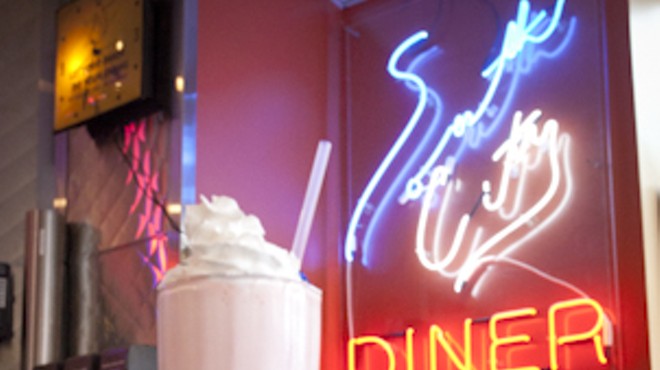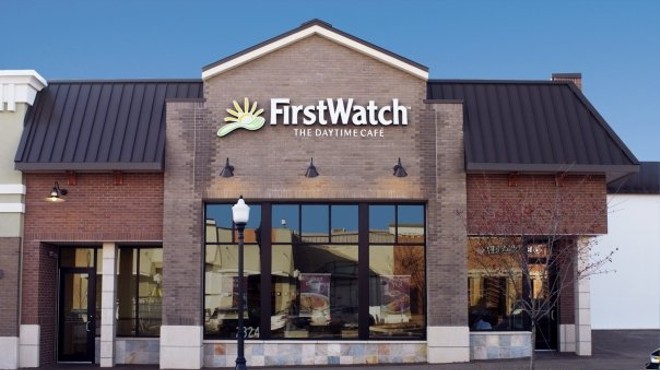Because atmosphere, accessibility to the metro area, amenities and quality of product are all important criteria on our winery scorecard, we just don't think you can beat the experience at Mount Pleasant in Augusta, Mo. (5634 High St., 636-482-4419). There's the charming estate and rolling vineyards; the range of live music; the mystery dinners and the superstar culinary events like the James Beard extravaganza; and the winemaking risk-taking, like trying to produce French- and California-style wines despite climatological obstacles. (Sometimes they succeed wildly, as with the Belle Yvonne red blend, and sometimes they reinforce why certain grapes just aren't grown around these parts.) But even if it's just a loaf of bread from the on-grounds Augusta Grocery and a jug of Mount Pleasant's vin ordinaire, this 140-year-old landmark is still our favorite place to pass the time with our favorite thou.
It certainly took a lot of Gaul to open up a restaurant like this in the Central West End. If you're not privileged enough to pop over to France on a regular basis, at least now you can stroll the Avenue Laclede whenever you feel like it and experience many of the same sights, sounds and smells you'd find a couple thousand miles away. Not only is Chez Leon a perfect architectural emulation of something off a side street in Paris, it also brings together the culinary dream team of Eddie Neill (of Café Provençal and Eddie's Steak and Chop), chef Claude Courtoisier and Leon Bierbaum, whose local career has spanned everything from waiter at the Cheshire Inn to one of the top wine experts in town at Cheshire Cellars and 9-0-5 to concierge at the Majestic Hotel. Steak frites, choucroute, pâtés, great wines, tartes, even an authentic bouillabaisse now and then -- all the classics of the sidewalks of Paris and many other parts of France are now available without the jet lag.
Perhaps you recall sipping a sweet, bracing iced coffee as you studied the menu at a Thai place on South Grand. Or letting a tangle of onion rings cool as you shouted over the bleating saxophone at a joint in U. City. Maybe you remember tasting your first black truffles at a white-napped table in Clayton or downtown. Each part of the city has exceptional restaurants that turn ordinary moments into blithe memories. Yet one colorful neighborhood surpasses all others in culinary diversity and aesthetic appeal. It has splendid pubs, bistros and cafes, from ethnic to eclectic. It has a dynamic sidewalk scene and serried outdoor tables perfect for idling in the wistful autumn sunshine. It has blues and bookstores, architecture and antiques, artists and panhandlers. It's the Central West End. This flourishing historic neighborhood occupies a treasured niche in our city's collective memory and imagination. Whirl and glide about the Starlight Roof at the Chase Park Plaza Hotel, just as Jazz Age minxes and their suitors once did. Then sup in one of the handsome hotel's two restaurants, Anton's and the Tenderloin Room. Culinary innovation thrives in eateries along the Central West End's restless thoroughfare, Euclid Avenue, and on its tranquil cross streets. Loaf on Bar Italia's breezy terrace as you uncork a bottle of Montepulciano and spread caponata on a heel of crusty bread. Inhale the heady perfume of amber-glazed roast duck at Zoë's Pan-Asian Café. Feast on seasonal indulgences, such as Balaban's fried soft-shell crab in the summer and Chez Leon's earthy wild-boar stew in the fall. Somehow the Central West End has a way of giving sustenance the giddy flavor of indulgence.
-
Central West End
Euclid Ave and Maryland Ave, St. Louis
St. Louis - Central West End
5
articles
Jim Fiala and Cary McDowell are seasoned craftsmen who can concoct an evening special in five minutes when they see what their fishmonger and produce supplier have brought them that morning. Give them, say, a whole bluefish, a few sprigs of fresh parsley and thyme, a side of bacon and an onion, and they'll whip up a superb bacon-wrapped grilled bluefish. Fiala and McDowell, chefs/owners of The Crossing, both completed rigorous culinary-school training, but their success is also grounded in their veneration of fine ingredients, their guileless yet graceful preparations and their deep, unwavering friendship. Since McDowell and Fiala opened their restaurant in April 1998, fish cookery has become their hallmark. They prepare tilapia, Alaskan halibut, black grouper, yellowfin tuna, Dover sole, Oregon red king salmon and other fish using the classic techniques of roasting, grilling, poaching, pan-searing and sautéing. Sometimes they sauce the fish to bring out its richness, but the flavor usually needs little embellishment. The chefs are adept at creating vegetable dishes and desserts, too. In fact, their warm chocolate torte and their composed salad of goat cheese and beets have become signature dishes. Pleasing his customers, McDowell says forthrightly, is gratifying: "To work towards making The Crossing a good restaurant, a great restaurant that people would want to come to over and over again, a place that's special to them -- that's the reward I get."
-
The Crossing
7823 Forsyth Blvd., Clayton
Clayton
314-721-7375
10
articles
Jay Jackson -- this man could sell a plate of fried fleas. But he now manages and waits tables at the Delmar Restaurant & Lounge in the U. City Loop and instead handles carefully designed plates of culinary accomplishment. Jackson, a waiter and bartender for most of his life, has worked everywhere from underground rock & roll clubs in Los Angeles to jazz bars in New York City. He knows his liquor, his spices, his table settings and his red wines. He's been a bouncer, a soldier and an entrepreneur, so his litany of jokes, insults and one-liners is well dressed in wit. When customers walk through the door, he sizes up their personalities with the finesse of a psychoanalyst and launches into a menu of suggestions to suit their temperaments. "The meal should be an experience," he insists. He also knows his jazz and has partied with the best. Formerly head bartender at Just Jazz in the Hotel Majestic, Jackson can explain to customers at the Delmar what's happening onstage with the patience of a primary-school teacher or converse fluently with aficionados. The Delmar is open 5 p.m.-3 a.m, with live music Wednesday-Sunday. On those nights, ask for Jay.
If you're looking for a pancake of pioneer proportions, you'd be hard pressed to match the plate-sized slabs from the grill of the South City Diner. For more than 60 years, the South City Diner has been a South St. Louis landmark. But in 1992, when Peter Spoto reopened it, the diner had been closed for three years. "It has a lot of history to it," says Spoto, the diner's owner/operator. "It was an old greasy-spoon, diner-type place, and it was only open for lunch. I updated it and upscaled it, the diner and the menu. Today it's a real, true New York-style diner. By that I mean it has a very large menu, and you can get breakfast, lunch or dinner any time of the day, which is indicative of a diner. There's no cutoffs: no 'breakfast stops,' no 'dinner stops.'" What this means is that the South City's hot, golden-brown flapjacks are available anytime you want. Or, rather, anytime you've got room -- these babies are an easy half-inch thick. "We get a lot of comments on how big they," says Spoto. "People aren't able to finish 'em. They're buttermilk pancakes, and we've got enough baking powder in them, so they rise pretty good. They're a pretty good meal. I think they're, what, 8, 10 inches across?" And on Sunday mornings, you can even get them with blueberries.
-
City Diner
3139 S. Grand Blvd., St. Louis
St. Louis - South Grand
314-772-6100
11
articles
For the breakfast connoisseur, a recently opened First Watch restaurant stands out like an oasis in the Sahara. True, St. Louis has no shortage of dining establishments that offer a decent breakfast, but there are few standouts here. Fans of a couple of the large national chains regularly form long lines outside those restaurants on Saturday and Sunday mornings, but what if one wants to forego walking through a maze of country tchotchkes or being sandwiched in a seating area the size of a cattle car?
First Watch offers a welcome alternative.
This pleasant, casual restaurant, which opened at the end of June off Olive Boulevard in Chesterfield, is open from 7 a.m.-2:30 p.m. and serves only breakfast, lunch and brunch. Its menu contains both an extensive list of healthier offerings and some true comfort food. A pitcher of icewater is standard on every table, and, for coffee drinkers, so is a bottomless carafe.
The menu contains generous servings of standard breakfast fare, like omelettes served with potatoes and an English muffin; made-from-scratch French toast, pancakes and Belgian waffles; and "sensational skillets," made with potatoes topped with melted cheese, eggs and such things as ham and mushrooms or avocado, bacon and onion or diced vegetables. For the health-conscious, there's the "tri-athlete omelette," with egg whites, mushrooms, onion, tomato, green chiles and low-fat cheese, or the fresh-fruit crê pes, two thin crê pes wrapped around fresh fruit and topped with strawberry yogurt, cinnamon and sugar.
More unusual items are also featured, like the turkey dill "crepeggs" -- a crê pe whipped with eggs and wrapped around diced turkey, mushrooms, fresh spinach, onions and Monterey Jack cheese, then covered with hollandaise, tomatoes and dill.
For lunch, there's a host of salads -- Greek, caesar, Cobb -- as well as unusual ones like Won's Oriental, which features teriyaki chicken breast, water chestnuts and cashews, sautéed in a sweet-and-sour dressing and piled on top of greens and crunchy oriental noodles. Sandwiches run the gamut from a chicken-salad melt -- with water chestnuts, raisins and celery on grilled multigrain bread with melted cheese and tomato -- to a BLT with a fried egg and cheese.
The chain's first restaurant opened 18 years ago on the bay in Monterey, Calif. -- where it derived its name and logo for the "first watch" in the morning -- after one of First Watch's partners heard about a guy who opened a strictly breakfast-and-lunch restaurant in Colorado because he wanted time to ski the slopes. The concept worked.
Ron Hendrix, a vice president of the Sarasota, Fla.-based company, says some people doubted whether a restaurant could succeed without serving dinner or alcohol, "but it provides us with a niche we can concentrate on." The company now has 35 locations in Florida, Arizona, Ohio, California and Missouri, including eight restaurants in the Kansas City area. Hendrix says First Watch is planning to open as many as four to eight restaurants in St. Louis. He is currently in lease negotiations for another site in Creve Coeur. Prices range from $2.75 for biscuits and gravy to $6.50 for an "Acapulco Express" omelette. There's also a kids' menu.
-- Laura Higgins
-
-
First Watch
8001 Forsyth Blvd., Clayton
Clayton
314-863-7330
3
articles
-
-
Attending the luncheon buffet at St. Mary's of Victories Church is like going to an urban parish picnic in the middle of the workday. Situated just south of the Arch, it has become popular with downtown workers -- lawyers, civil servants, judges and anyone else in search of home cooking. There's the inevitable comparison with St. Raymond's Maronite Church and its famous Wednesday luncheon; according to one buffet buff who frequents both, "St. Raymond's has more politicians, though St. Mary's is more serious about food." The lavish spread is cooked and served by a dedicated group of volunteers whose common purpose is to contribute to the upkeep of the beautiful old church. Except for the Hungarian entrée, "every thing is cooked Southern-style," says longtime volunteer Peggy Downen. Chicken and dumplings, usually served once a week, seems to be the favorite. Also, leave time for a tour of the church, ably conducted by Walter O'Farrell. He'll show you the grotto, reminiscent of Lourdes; the massive pipe organ; and the upper tier where the Franciscan sisters of St. Mary's slept during the cholera outbreak of 1866, having given up their own beds to tend to the patients in the adjacent hospital. St. Mary's Church was built in 1843 and for many years had a school and hospital attached. The hospital, still called St. Mary's, moved west to Clayton Road, and the defunct school now serves as the dining hall for the buffetgoers. The Hungarian connection stems from the local Hungarian Catholic community, which received permission from the Archdiocese to reopen the shuttered church in 1972, under the banner of St. Stephen of Hungary Parish. The buffet was served routinely on Sundays after Mass, but a year ago it was expanded to include Monday, Tuesday and Wednesday. On a recent visit, the fare consisted of goulash, mashed potatoes, candied yams, baked ham, corn niblets, green beans, cole slaw, green salad, frontier salad (cucumber and onions), a spinach soufflé, rolls and eight different kinds of pie and cake. The line moves right along, and the price of $6 buys you a drink and all you care to eat.
You can check and recheck the desayunos board at Taqueria Azteca for migas, which can rightly be considered the breakfast of the gods, but what you'll find is huevos è la Mexicana. Simplicity itself, the dish is practically elemental: eggs, scrambled with tomatoes, onions and peppers. Simple does not mean easy, though, which obviously it is not, because no one else in St. Louis gets it right. And it's not just the eggs, darkened slightly and suffused with smokiness; it's the entire plate. The rice is firm; the beans are soupy, rare this far north, and topped with crumbled queso blanco. (Are they vegetarian? We don't want to know.) There's sometimes avocado, sometimes sour cream, and warm, fragrant corn tortillas. The salsa varies but is generally either a tart, spicy verde or, preferably, a rojo that can sting (the chilequiles rojos can provide reminders of its goodness well into the next day). There's not much in the way of ambiance, and you'll learn to accommodate the rhythms of the service, but what is it you want exactly, anyway? It's not just the best Mexican breakfast in town, it's the best Mexican and the best breakfast.
Most Mexican restaurants, including many that serve delicious food, look like little theme parks of Mexican culture. Hey, a few miniature sombreros and corny clay pots never hurt the mole sauce, so who cares, really? But if you want a genuinely Mexican environment as you eat your ceviche or lingua taco, washed down with horchata, then cross the river and visit Tienda El Ranchito in Fairmont City, a few miles down the road from Cahokia Mounds. You will find a down-home Mexican market staffed by folks of Mexican descent, frequented almost solely by same, with kids running around underfoot. There are nice selections of piatas, salsas and Mexican music, some of which will be blaring agreeably from the overhead speakers. Back in the restaurant space, yes, there is a wall painting of a matador, but it is so naively executed that no wannabe restaurant would dare display it. If you are the real thing, you don't have to dress the part (not that you won't find the odd table of Mexican cowboys totally dressed the part, in splendid boots and hats, drinking Coca-Cola bottled south of the border). Every wall could use a coat of paint, sure, but that never hurt the chile relleno, either. And if it gets that paint, you know it won't come in any carefully themed Mexican rainbow. Nope -- just slap it on and get back to the real deal, honest food and life.
-
Tienda El Ranchito
2565 N. 32nd St., Fairmont City
East St. Louis/ Cahokia
618-875-1521
3
articles
Guacamole is as controversial as politics, religion and barbecue. Purists favor the strapping California avocado over its puny Florida cousin. Dogmatists spurn creamy versions of the dish and endorse chunky ones. Rival factions quarrel about ingredients: Tomatoes or tomatillos? Serranos or jalapenos? Scallions or white onions? Curry or cumin? And cookbooks perpetuate loathsome perversions of the recipe, such as stirring in a packet of commercial taco-seasoning mix, adding grated cheddar cheese and -- most odious of all -- cutting the guacamole with sour cream. Babalu's, a Caribbean place in the Central West End, has the most glorious guac in town. Chef Dana Holland mashes supple, buttery California avocados with tomatoes (beefsteak, Roma or cherry, depending on what's ripe), roasted garlic, scallions and lime juice. Then he adds a splash of coconut milk and a pinch of calypso pepper, a house spice mix that includes chipotle and ancho chiles, cayenne, cinnamon and ginger. Instead of tortilla chips, the guacamole is scooped up with mariquitas, vertically sliced plantains that warp into brittle corkscrews when fried into chips. Holland anchors the wavy tendrils here and there in a mound of guacamole so that the striking finished platter resembles undulating fronds of sea kelp or a blond head of Medusa.
-
Babalu's
150 E. Argonne Drive, Kirkwood
Kirkwood
314-706-0793
2
articles
















